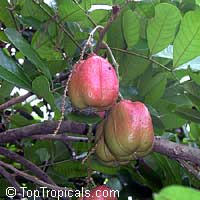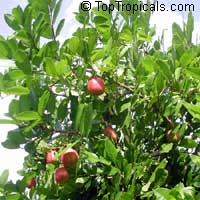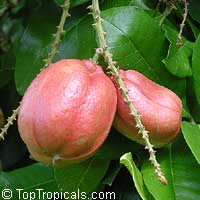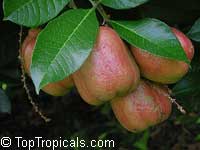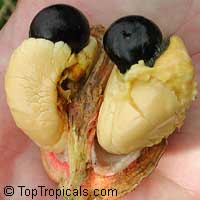Featured plant - a special for your collection
Blighia sapida (Akee) - Jamaican National Fruit
|
|
Scientific name: Blighia sapida, Cupania sapida Blighia sapida (Akee) is widely cultivated in tropical and subtropical regions for its fragrant flowers and colorful fruits. It gained its fame in Jamaica where it was imported long ago and has become the main ingredient to many popular dishes there. It was originally introduced in Jamaica and named by Captain William Bligh. He brought the fruit from West Africa to Kew in Jamaica in 1793. It was also introduced to Haiti, Cuba, Puerto Rico, Barbados and others. It has been later introduced to Florida in the United States. Ackee now is the national fruit of Jamaica. Akee is related to the Lychee and the Longan, and is an evergreen tree that grows about 25-30 ft tall, with a short trunk and a dense crown. Ackee fruit grow in bunches on powerful, strong-rooted trees. The flowers are unisexual and fragrant. They have five petals and are greenish-white. The fruit is pear-shaped. When it ripens, it turns from green to a bright red to yellow-orange, and splits open to reveal three large, shiny black seeds, surrounded by soft, creamy or spongy, white to yellow flesh - arilli (arils). The fruit turns bright red on reaching maturity and splits open along the seams with continued exposure to the sun. When open it reveals three large black shiny seeds and bright yellow flesh. Traditionally it is at this time that the ackees are harvested. In the Caribbean, there are two bearing seasons: between January to March and June to August. In Florida, flowers appear in spring and the fruits in mid summer and there may be a light blooming period in the fall. The fruit of the Ackee has a nutty flavor but is not edible in entirety. It is only the fleshy arils around the seeds that are edible while the remainder of the fruit and seeds are poisonous. The fruit must only be picked after the fruit has opened naturally, and must be fresh and not overripe. The fleshy arils are poisonous until fully exposed to light. Never open an ackee pod, because it is poisonous if eaten before it is fully mature. The seeds are always poisonous. When the fruit has "yawned", the seeds are discarded and the arils, while still fresh and firm, are best parboiled in salted water or milk and then lightly fried in butter. Then they are really delicious. In Jamaica, they are often cooked with codfish, onions and tomatoes. After parboiling, they are added to a stew of beef, salt-pork and scallions, thyme and other seasonings. Sometimes they are curried and eaten with rice. They are served, not only in the home, but also in hotel dining rooms and other restaurants. In Africa, they may be eaten raw or in soup, or after frying in oil. When boiled, drained and simmered in oil with salted dried cod with your choice of vegetables and hot peppers, it becomes Jamaica's national dish "Ackee and Saltfish". Salt cod is sauteed with ackee (boiled), pork fat, onions, peppers, tomatoes, herbs, and may be garnished with crisp bacon and fresh tomatoes. Considered as a delicacy by many, cooked ackee has the consistency and look of scrambled eggs. It is enjoyed by many at breakfast or as an entree throughout Jamaica. The purified oil from ackee has high nutritive value. Canned ackees are exported wordwide and is available in West Indian markets. It is a major export product in Jamaica. Other uses: The oil of the ackee arils contains many important nutrients, especially fatty acids. Growing a tree The Akee tree is tropical to subtropical. It fruits heavily in southern Florida. Young trees can be killed by freeze but mature trees have escaped serious injury during brief periods of 26°F. It is reported to able to survive temperatures to the upper 20's. It seems to grow a bit better in areas that cool during the winter, rather than intense humid, tropical climates. The tree does very well on poor soils, even on limestone and sand in southern Florida, though it grows faster in more fertile soils. Order the plant: |
